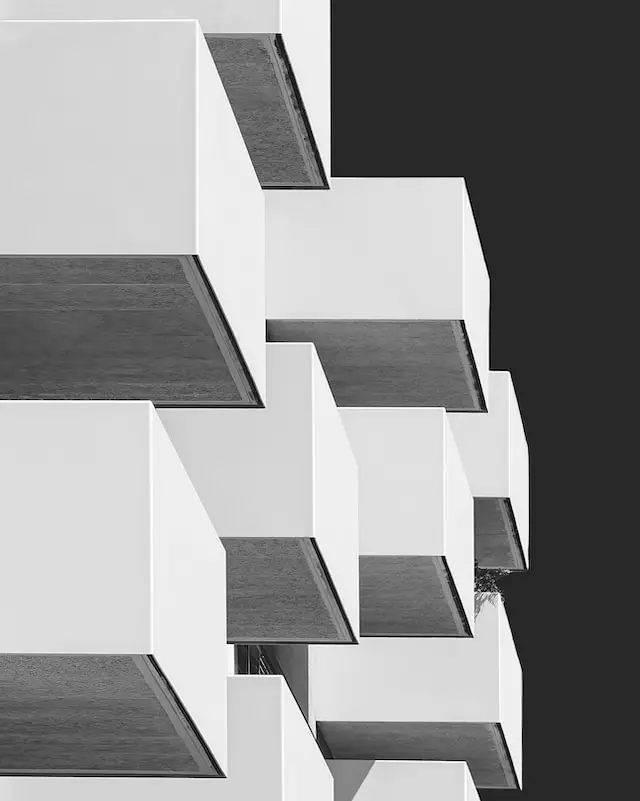Cantilever beams are often used when there is a need for extra support at one end of the beam. This type of beam is also well suited for applications where vibration or movement needs to be minimized. Simply supported beams, on the other hand, are often used in applications where weight needs to be evenly distributed along the length of the beam.
What is a cantilever beam?
(Photo by Ricardo Gomez Angel on Unsplash )

A cantilever beam is a structural element that is supported at only one end and extends horizontally into space, without any additional support at the other end. It is a type of beam that is fixed at one end and free at the other, creating an overhanging configuration. The supported end of the beam is usually attached to a wall, column, or any other stable structure.
Here are some key characteristics and considerations related to cantilever beams:
- Support and Load Distribution: The fixed end of the cantilever beam provides support and resists the bending moment, while the free end is subjected to external loads. The beam transfers these loads to the fixed end, creating bending stress and deflection along its length.
- Structural Stability: Cantilever beams rely on the strength and stability of the fixed support. The support must be capable of resisting the bending moment and shear forces generated by the applied loads. Adequate design and structural analysis are essential to ensure the stability and safety of the cantilever beam.
- Applications: Cantilever beams are commonly used in various structural and architectural applications. For example, they can be found in buildings to create overhanging balconies, canopies, or awnings. Cantilever beams are also used in bridges, cranes, cantilever shelves, and other structures that require extended horizontal projections without intermediate supports.
- Bending Moment and Deflection: Due to the unbalanced nature of the cantilever beam, it experiences significant bending moments and deflection under applied loads. The magnitude of bending moment and deflection depends on the type and distribution of loads, beam dimensions, and material properties.
- Structural Analysis: Designing a cantilever beam involves analyzing its structural behavior and ensuring it can safely support the intended loads. Structural engineers consider factors such as material strength, beam dimensions, load conditions, and desired deflection limits to determine the suitable design for a given application.
- Material Selection: Cantilever beams can be constructed from various materials, including steel, concrete, timber, or composite materials. The material choice depends on factors such as load requirements, aesthetic considerations, environmental conditions, and project specifications.
- Reinforcement and Support: In some cases, cantilever beams may require additional reinforcement or support to enhance their structural integrity. This can include the use of reinforcing bars, tension cables, or supplementary supports to counteract the bending moments and increase load-bearing capacity.
Cantilever beams offer unique design possibilities and architectural aesthetics by allowing structures to extend beyond their supporting points. However, it is crucial to ensure proper engineering and construction practices to ensure the stability, safety, and functionality of cantilever beam structures.
What is a simply supported beam?
A simply supported beam is a structural element that is supported at two ends and freely rests on these supports. It is one of the most common types of beams used in construction and engineering applications. The two supports, typically columns, walls, or beams, provide vertical reactions that balance the weight of the beam and any applied loads.
Here are some key characteristics and considerations related to simply supported beams:
- Support Conditions: Simply supported beams have a clear distinction between the supported ends and the free span between them. The supports act as points of restraint, preventing vertical movement and rotation of the beam at these points.
- Load Distribution: Simply supported beams distribute the applied loads primarily as bending stress along the length of the beam. The beam transfers the load to the supports, generating bending moments and shear forces.
- Structural Behavior: When a load is applied to a simply supported beam, it deflects under the influence of bending. The maximum deflection occurs at the center of the span, while the ends remain fixed due to the supports. The beam experiences bending moments that are highest at the supports and decrease toward the center of the span.
- Design Considerations: Designing a simply supported beam involves considering factors such as the magnitude and distribution of loads, the span length, the material properties, and the desired deflection limits. Engineers perform structural analysis to ensure the beam can safely support the applied loads without exceeding its strength or deflection limits.
- Materials and Cross-Sectional Shapes: Simply supported beams can be constructed from a variety of materials, including steel, concrete, timber, or composite materials. The choice of material depends on factors such as load requirements, structural design, cost considerations, and desired aesthetics. The cross-sectional shape of the beam can vary, such as rectangular, I-section, T-section, or circular, depending on the structural requirements and material characteristics.
- Reinforcement and Prestressing: In certain cases, simply supported beams may require additional reinforcement or prestressing to enhance their load-carrying capacity or minimize deflection. Reinforcing bars or prestressed cables can be used to strengthen the beam and increase its resistance to bending moments and shear forces.
- Applications: Simply supported beams are widely used in various structural applications, such as bridges, buildings, floors, roofs, and supports for equipment or machinery. They provide a simple and efficient means of spanning distances and supporting loads while ensuring structural stability.
It is important to note that the supports of a simply supported beam should be capable of resisting the applied loads and providing adequate stability. Proper design, material selection, and construction practices are crucial to ensure the safety and functionality of simply supported beam structures.
Key differences between cantilever and simply supported beams
The main difference between the two is in the amount of bending that occurs. Simply supported beams have very little bending, while cantilever beams can bend a lot. This is because the force is applied to only one point on a cantilever beam, while it is evenly distributed along the length of a simply supported beam.
Another difference between the two types of beams is their strength. Cantilever beams are typically stronger than simply supported beams since they can better distribute weight and force. However, this also means that cantilever beams are more likely to break if not properly designed.
How to choose the right beam for your project
The type of structure, the loads that need to be supported, the span of the beam, and the environment where the beam will be installed are all important considerations you need to look into before deciding the type of beam you intend to use.
Beams can be made from a variety of materials, including wood, steel, concrete, and aluminium. Each material has its advantages and disadvantages that need to be considered. Wood beams are strong and lightweight, but they can rot and are susceptible to fire. Steel beams are very strong, but they are also very heavy. Concrete beams are very durable, but they can be difficult to work with. Aluminium beams are lighter than steel beams, but they may not be as strong.
The span of the beam is another important consideration. Beams can span short distances or long distances. Short spans are typically used for small structures such as decks and sheds. Long spans are often used for larger structures such as bridges and buildings. The weight of the beam must be considered when choosing a span. Heavier beams can span longer distances than lighter beams, but they may also require more support.
The environment where the beam will be installed is also an important consideration. Beams that will be exposed to weather or chemicals will need to be made from materials that can resist those conditions. Beams that will be supporting a lot of weight or that will be subject to vibration will need to be made from materials that can handle those loads without failing.








